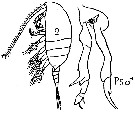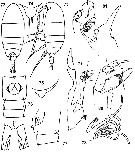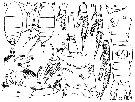|
|
 |
Fiche d'espèce de Copépode |
|
|
Calanoida ( Ordre ) |
|
|
|
Clausocalanoidea ( Superfamille ) |
|
|
|
Diaixidae ( Famille ) |
|
|
|
Diaixis ( Genre ) |
|
|
| |
Diaixis pygmaea (T. Scott, 1896) (F,M) | |
| | | | | | | Syn.: | Scolecithrix pygmaea T. Scott (after Pearson, 1906, p.19).
Diaixis durani : Corral Estrada, 1972 a (p.51, Descr.M, figs.M); Andronov, 1979 (p.95, Descr.F, figs.F,M); Andronov & Maigret, 1980 (p.71, Table 2); Vives, 1982 (p.292); Valdés & al., 1990 (tab.2); Bradford & al., 1983 (p.123); Valdés & al., 2007 (p.104: tab.1); Bode & al., 2003 (p.85, Table 1, abundance); | | | | Ref.: | | | van Breemen, 1908 a (p.82, figs.F,M); Pesta, 1920 (p.518); Früchtl, 1924 (p.220, Rem.: parasite); Rose, 1933 a (p.160, figs.F,M); Bradford & al., 1983 (p.123); Avancini & al., 2006 (p.89, Pl. 58, figs.F,M, Rem.); Vives & Shmeleva, 2007 (p.641, figs.F,M, Rem.) |  issued from : M. Rose in Faune de France, 1933, 26. [p.160, Fig.178]. After Sars, 1925. Female: habitus. Nota: head and Th1 fused, Th4 and Th5 separate. Postero-lateral corners of Th5 acute. Male: P5.
|
 issued from : V.N. Andronov in Arthropoda Selecta, 2002, 11 (1). [p.25, Figs.72-81]. After Andronov, 1979. Female: 72-73, habitus (dorsal and lateral, respectively); 74, rostrum; 75, segment thoracic 5 (left lateral side); 76, urosome (ventral); 77, genital segment and urosomal segment 2 (left lateral side); 78, distal end of Mx2. Male: 79, P5; 80-81, distal end of left P5 (different views).
|
 issued from : V.N. Andronov in Byull. Mosk. Obshch. Ispyt. Prir. , Otdel Biol., n. ser., 1979, 84 (4). [p.96, Figs.14-28]. As Diaixis durani. Female (from W coast Africa): 14, 16, habitus (dorsal and lateral, respectively); 15, rostrum; 17-20, P1 to P4; 21, last thoracic segment (left lateral side); 22, genital segment and urosomal segment 2 (left lateral side); 23, urosome (ventral); 24, A2; 25, Mx1; 26, distal segments of Mx2; 27, Mxp; 28, Md.
| | | | | Ref. compl.: | | | Pearson, 1906 (p.19, Rem.); Rose, 1925 (p.152); Rose & Vaissière, 1952 a (p.120); Mazza, 1966 (p.71); Paulmier, 1971 (p.168); Apostolopoulou, 1972 (p.328, 352); Comaschi Scaramuzza, 1978 (p.17); Kovalev & Shmeleva, 1982 (p.84); Vives, 1982 (p.292); Regner, 1985 (p.11, Rem.: p.32); Comaschi Scaramuzza, 1987 (tab.1); Pancucci-Papadopoulou & al., 1990 (p.199); Ragosta & al., 1995 (Appendix A); Hajderi, 1995 (p.542); Hure & Krsinic, 1998 (p.53, 101); Siokou-Frangou, 1999 (p.476); Holmes, 2001 (p.54); Beaugrand & al., 2002 (p.179, figs.5, 6); Vukanic, 2003 (139, tab.1); Isari & al., 2006 (p.241, tab.II); Valdés & al., 2007 (p.104: tab.1); Cabal & al., 2008 (289, Table 1); Brugnano & al., 2010 (p.312, Table 3); Mazzocchi & Di Capua, 2010 (p.425); Mazzocchi & al., 2011 (p.1163, fig.6, long-term time-series 1984-2006); Isari & al., 2011 (p.51, Table 2, abundance vs distribution); Madurell & al., 2012 (p.1078, submarine pump); Mazzocchi & al., 2012 (p.135, annual abundance 1984-2006); Aubry & al., 2012 (p.125, table 3, fig. 8 a, b, interannual variation); Belmonte & al., 2013 (p.222, Table 2, abundance vs stations); Lidvanov & al., 2013 (p.290, Table 2, % composition) ; Benedetti & al., 2016 (p.159, Table I, fig.1, functional characters); El Arraj & al., 2017 (p.272, table 2, spatial distribution); Belmonte, 2018 (p.273, Table I: Italian zones) | | | | NZ: | 4 | | |
|
Carte de distribution de Diaixis pygmaea par zones géographiques
|
| | | | | |  Issued from : M.G. Mazzocchi, L. Dubroca, C. Garcia-Comas, I. Di Capua & M. Ribera d'Alcalà in Progr. Oceanogr., 2012, 97-100. [p.143, Fig.10]. Issued from : M.G. Mazzocchi, L. Dubroca, C. Garcia-Comas, I. Di Capua & M. Ribera d'Alcalà in Progr. Oceanogr., 2012, 97-100. [p.143, Fig.10].
Long-term variability of the abundance (Ind. m3) of rare copepod species that disappeared in the second period of the time-series at Station MC (Gulf of Naples), by vertical tows in the upper 50 m. |
| | | | Loc: | | | Angola, Congo, Morocco-Mauritania, off Madeira, off Coruña, NW Spain, Bay of Biscay (Belon estuary), Scotland, Ireland, Medit. (Algiers, Balearic Sea, G. of Lion (Thau Lagoon), Ligurian Sea, Tyrrhenian Sea, G. of Naples, Taranto, Adriatic Sea, Venise, G. of Manfredonia, Aegean Sea, Thracian Sea, Lebanon Basin, Marmara Sea), | | | | N: | 44 | | | | Lg.: | | | (307) F: 0,95; M: 0,95; (379) F: 0,86-0,74; M: 0,74-0,68; (380) M: 0,76; (449) F: 0,95; (881) F: 0,74-0,95; M: 0,68-0,74; {F: 0,74-0,95; M: 0,68-0,95} | | | | Rem.: | hyperbenthique. Sampling depth: 0-300 m.
Voir aussi les remarques en anglais | | | Dernière mise à jour : 28/10/2022 | |
|
|
 Toute utilisation de ce site pour une publication sera mentionnée avec la référence suivante : Toute utilisation de ce site pour une publication sera mentionnée avec la référence suivante :
Razouls C., Desreumaux N., Kouwenberg J. et de Bovée F., 2005-2025. - Biodiversité des Copépodes planctoniques marins (morphologie, répartition géographique et données biologiques). Sorbonne Université, CNRS. Disponible sur http://copepodes.obs-banyuls.fr [Accédé le 26 décembre 2025] © copyright 2005-2025 Sorbonne Université, CNRS
|
|
 |
 |






